North Sea
Regional Update
A good year for offshore rig owners is getting better
Forecasts of offshore rig demand exceeding supply, and over 40 new rigs ordered, point to the long-awaited turnaround.
Tom Marsh, ODS-Petrodata
When push comes to shove, we have to call the current offshore industry situation a “boom,” at least from the perspective of offshore drilling contractors. With more than 40 new rigs on order (and more orders inevitable), day rates for certain rig classes at record levels in some parts of the world, and a forecast that indicates offshore rig demand will outstrip supply, what other word can we use?
Of course, boom implies bust at some point, so given the roller coaster ride the offshore contract drilling industry has been on since the late 1970s, maybe it’s natural to shy away from the “B” word. In any case, given where the industry is right now, offshore rig owners are in their best situation in years, and the outlook is extremely positive.
US GULF OF MEXICO
Owners with rigs working in North America, in particular in the US Gulf of Mexico, are riding the same rising tide of day rates seen elsewhere. While gains in jackup day rates have been solid, increases in floating-rig rates have outpaced all forecasts by a wide margin, Fig. 1.
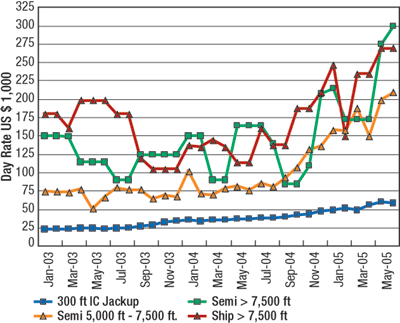 |
Fig. 1. Average US Gulf of Mexico MODU day rates, 2003 to present.
|
|
In absolute terms, the increase in rig demand in the US Gulf over the past year has not been huge: The region’s contracted rig count in June 2005 stood at about 132, up only some 16 rigs from June 2004. The difference is the nature of the current rig market. In much of 2004, rig owners could find their rigs idle for days or even weeks between jobs. Many rigs now have longer, firm commitments from operators, little if any idle time between contracts with different operators, and they are building contract backlogs. Coupled with a slight net decline in supply over the last year, the resulting tightened market gives rig owners opportunity and leverage to increase rates.
Four rig classes illustrate the general day rate trend in the US Gulf. In January 2005, the market rate (the rate based on recent contract signings) for independent-leg cantilever jackups rated for 300 ft, was $49,500/day on average. By June, the average rate for these rigs had increased to $58,930/day.
In the US Gulf floating rig market, the market rate for mid-water depth semis (rigs rated to work in water depths ranging from 5,000 ft to 7,500 ft) stood at $158,000/day on average in January, compared to $209,523/day in June. Deepwater semis went from an average market rate of $215,000/day to $300,000/day over the same six-month period, while deepwater drillship rates rose from an average of $247,500/day to $270,000/day. All of the floating rig day rate increases followed even larger percentage rate increases recorded in the last six months of 2004.
NORTH AMERICA REGION
Rig markets in the US Gulf, Canada, Mexico and Trinidad are closely linked. According to ODS-Petrodata’s June rig demand forecast, overall demand in the wider region encompassing these four countries will increase by seven jackups and 10 floating rigs over the next 12 months. This 17-rig increase in demand, all of which likely will take place in the US Gulf, will not be met by the currently projected offshore rig supply in the region. The shortfall will be in the US Gulf floating rig market where, by the middle of next year, projected demand will outpace projected supply by five rigs.
Canada will play little role in the region’s offshore market over the next year. Offshore rig demand in Canada is unlikely to change much one way or the other with, at most, four to five rigs working in Canadian waters at any given time.
Mexico remains a wild card of sorts. The bulk of the rigs under contract to Pemex are owned by US-based drilling contractors. It was increasing activity on Pemex’s part that boosted the sagging fortunes of some US rig owners beginning in 2002, when US Gulf utilization was merely 63%.
Now, a presidential election looms in 2006 in Mexico. Pemex, intertwined as it is with the government, will be impacted. Election-related politics may already be playing a role in Pemex’s approach to its deepwater exploration ambitions, which have been scaled back.
About one-half of the rigs Pemex has under contract will reach the end of their existing contract commitments before the election takes place next June. Whether Pemex will have the will or ability to maintain its present level of activity in the run-up to the election and beyond is a question that cannot be answered with certainty at this time. For now, the forecast is for little change in demand on the part of Mexican state oil company Pemex. Under this scenario, over the next 12 months, Pemex is likely to have about 30 jackups and nine semis under contract.
Trinidad remains a small outpost of sorts for US-based drilling contractors. However, much as with Canada, offshore rig demand in Trinidad is not expected to change significantly from its five-rig level over the next 12 months.
GLOBAL CONTEXT
ODS-Petrodata’s most recent forecast of worldwide offshore rig supply and demand, prepared in early June, points to a growing equipment shortage in some rig market segments, Fig. 2. Under the forecast’s basic assumptions of relatively stable oil and natural gas prices and no major social or economic upheaval, worldwide demand for offshore rigs will outstrip available supply in October of this year. The situation will become more acute in 2006, with demand outstripping supply by as much as 36 rigs by April of next year.
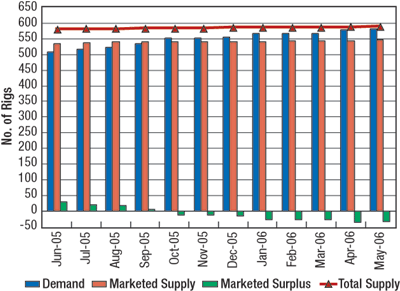 |
Fig. 2. ODS-Petrodata offshore rig demand forecast, June 2005-May 2006.
|
|
Some offshore rig markets will experience shortages sooner than October; the case can be made that shortages exist now in certain market segments. For instance, as of early June, no semis or drillships were immediately available for work in the US Gulf of Mexico, and no rigs of any type were immediately available for work in West Africa or the Asia/ Pacific region.
As is always the case when the rig market tightens, day rates are on the rise. In January of this year, North Sea jackup market rates ranged from $50,000/day to $100,000/day. In June, North Sea jackups were on contracts ranging from $85,000/day to $145,000/day. Market day rates for jackups in West Africa ranged from $44,500/day to $77,500/day in January; in June, market rates for these rigs were $58,000/day to $105,000/day.
However, the big money is in West Africa’s deep waters. High specification, deepwater floating rigs were earning $135,000/day to $212,500/day in January. By June, owners of these rigs were commanding rates as high as $318,500, although the low end of the range was around $155,000/day.
Some industry observers believe day rates in excess of $400,000 will materialize this year. Whether rates at this level will represent a wider trend will only be known over time.
SUPPLY VS. NEW RIG CONSTRUCTION
The fact that offshore rig demand will outstrip supply this year has not been lost on some rig owners and market speculators. Since January 1, orders for 24 new rigs have been placed with shipyards, bringing the total number of rigs under construction worldwide to 41. Of these, four are being built specifically to work for national oil companies, three have contract commitments, and the remaining 34 are being built on speculation. Thirteen are being built by companies that fall outside the traditional drilling contractor category, i.e., they are true market speculators.
That the speculators have moved into the offshore rig market points to a wider perception of the industry’s strength over the longer term. The majority of these new rigs will not be delivered until 2007 and beyond. If present rig market conditions remain intact, these new rigs will have no trouble finding work.
But, then again, boom does imply bust at some stage. 
| |
Day rate indices post new highs in four categories |
|
| |
July 8, 2005: Offshore rig day rates continue to rise in most rig market segments, according to ODS-Petrodata’s monthly Offshore Rig Day Rate Indices (see last paragraph for definition). North Sea jackup rates in particular increased significantly since last month, reflecting continued strong seasonal demand for the type in the region.
1. The North Sea Jackup Day Rate Index rocketed to 377 this month, by far the highest level achieved by the index since its inception. The average day rate in the North Sea non-harsh environment jackup market has topped $99,000, and rates in excess of $100,000 are common. Most of the rigs in the fleet have work commitments and/or options that extend well into 2006, if not beyond, and rig owners will reap the benefits of this strong demand over the coming months in the form of even higher day rates.
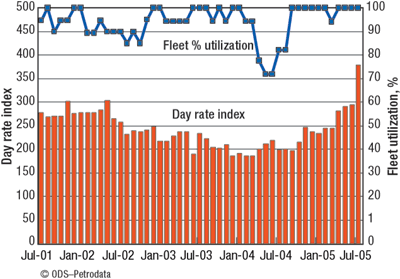 |
North Sea Competitive Jackup (non-harsh environment) day rate index. Current month (July 2005) = 377; 1994 = 100.
|
|
2. The US Gulf of Mexico Jackup Day Rate Index rose to 257 this month, topping the record high set just one month ago. US Gulf rig owners will be able to leverage strong demand for their services into even higher rates as the year progresses, but rising costs may impact some operators’ decisions concerning their drilling programs.
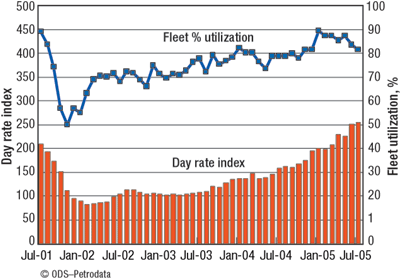 |
US Gulf of Mexico (250-ft – 300 ft), Competitive Jackup day rate index. Current month (July 2005) = 257; 1994 = 100.
|
|
3. The Deepwater Rig Day Rate Index hit 412 this month, the first time the index has risen above 400 since its inception. Worldwide demand for deepwater drilling rigs will exceed available supply before year-end, leaving some operators with no choice but to delay planned drilling programs.
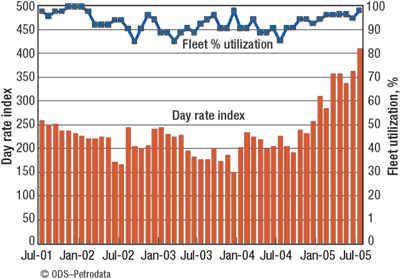 |
Deepwater Worldwide Competitive (5,001 ft +) Floating Rig day rate index. Current month (July 2005) = 412; 1994 = 100.
|
|
4. The Mid-Water Depth Semisubmersible Day Rate Index stands at 338 this month, pulling back from the all-time high of 409 established last month. This in no way indicates any softening in the market, as factors driving the market are unchanged. Recent contracts in West Africa and Northwest Europe have seen rates exceeding $160,000 per day; and rigs with certain capabilities remain in strong demand worldwide.
ODS-Petrodata Day Rate Indices track the movement of competitive mobile offshore drilling fleet day rates and utilization for four rig categories. Day rates are charted as an index, with the average market day rate in January 1994 equal to 100. Utilization is the percentage of contracted rigs out of the total competitive fleet supply. Data is updated on the second Friday of each month. Additional information is available from ODS-Petrodata in Houston, Aberdeen and Oslo. 
 |
Mid-water Worldwide Competitive (2,001 ft- 5,000 ft) Semisubmersible day rate index.
Current month (July 2005) = 338; 1004 = 100.
|
|
|
|
|
THE AUTHOR
|
| |
Tom Marsh, Publisher-U.S.A. for ODS-Petrodata, graduated from Texas A&M University’s Texas Maritime Academy in 1980 with a BS degree in Marine Transportation and an unlimited U.S. Coast Guard Merchant Mariners license as Third Mate. After graduating, he sailed as Third Mate through the International Organization of Masters, Mates and Pilots. He joined ODS-Petrodata’s predecessor Offshore Data Services in 1987, and has since served in a variety of editorial and research roles Prior to joining ODS, he worked for over five years as a marine surveyor and claims adjuster with an international energy insurance adjuster, involved in a wide variety of vessels engaged in offshore work.
|
|







